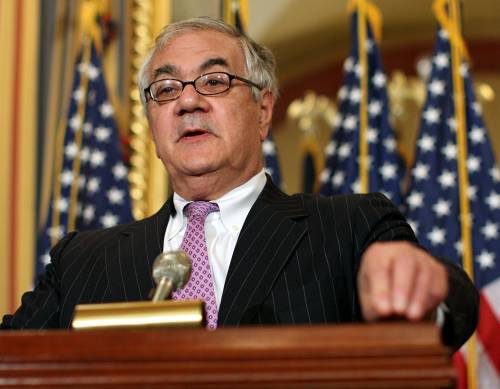Battling the CRA Myth
The Community Reinvestment Act has been a lightning rod for conservative criticism for years, but the scorn really took off when the housing market collapsed last year.
Jul 31, 2020287.7K Shares3.8M Views
Rep. Barney Frank (D-Mass.) (WDCpix)
Amid the ongoing debate over mortgage lending reform, a top federal regulator took a seat before Congress last week and debunked the myth — popular among conservatives — that a law encouraging loans to low-income communities has been largely responsible for the nation’s housing crisis.
“I can state very definitively,” Sandra Braunstein, director of the Federal Reserve’s consumer and community affairs division, said during a House Financial Institutions subcommittee hearingWednesday, “that from the research we have done, the Community Reinvestment Act is not one of the causes of the current crisis.”
Illustration by: Matt Mahurin
The statement may have come as a surprise to some of the panel Republicans, who have made a habit of fingering the CRA as a leading cause of the financial downturn. Enacted under the Carter administration, the law has been a lightning rod for conservative criticism for years, but the scorn really took off when the housing market collapsed last year. Critics claim that the CRA forced lenders to make bad loans to low-income borrowers who ultimately couldn’t pay them back.
Braunstein’s testimony, supported by a Fed analysis and echoed by other finance regulators in recent months, could add force to a recent Democratic push to expand the CRA to cover non-bank financial institutions, including mortgage companies, securities firms, credit unions and insurance companies. The bill aims to boost not only lending, but also investments and other services in minority and low-income neighborhoods.
Yet some myths don’t die easy. And Republicans — backed by the finance industry and encouraged by conservative pundits— appear as willing as ever to blame the CRA for the collapse of the housing market. Indeed, Rep. Jeb Hensarling (R-Texas) reiterated that argument at last week’s mortgage reform hearing, claiming that the CRA “helped put the federal government’s seal of approval, not so much on helping raise the economic opportunities of the borrower, but instead bringing down the lending standards of the lender.”
“I know the intent was noble,” Hensarling added, “but the effect has been devastating.”
Yet Braunstein’s testimony told a different tale. She cited a Federal Reserve Board analysis which found that, in 2006, CRA-covered banks operating in CRA-targeted neighborhoods accounted for just six percent of the risky, high-cost loans largely responsible for the housing crisis. Mortgage loans are considered high-cost when interest rates are at least three percentage points higher than those of conventional mortgages.
“So I can tell you,” Braunstein said, “if that’s where you’re going, that CRA was not the cause of this loan crisis.”
The debate arrives as Democrats are pushing an array of finance regulation reforms in efforts to stabilize the housing market and discourage the bad loans that led to the current crisis. Supporters are hoping that the economic turmoil — not to mention the finance industry’s role in bringing it about — will provide an opportunity to move those reforms.
Yet many of those proposals — like legislation allowing struggling homeowners to file for bankruptcy protection to keep their homes — are opposed by most in the finance industry. The banks — even those accepting billions of dollars in federal bailout funds — continue to lobby against such legislationand contribute to political campaigns, granting those institutions enormous sway even despite their own economic woes and reliance on federal lifelines.
Indeed, the mortgage bankruptcy bill, which the House approvedearlier this month, has since stalled in the Senatein search of the 60 votes it needs to pass. Despite industry-friendly concessions added in both chambers, most banks remain opposed to the bill.
Not that that’s stopping some Democratic leaders from charging ahead. House Financial Services Committee Chairman Barney Frank (D-Mass.) saidhe hopes to pass anti-predatory lending legislation before the Easter recess, while bills to reform the credit card industry and create a systemic risk regulator are also in the works. Frank also supports the push to expand the CRA, though Frank spokesman Steve Adamske said it’s not yet clear whether Democrats will try to attach it to one of the other finance reform bills. In the Senate, Banking Committee Chairman Christopher Dodd (D-Conn.) has his eyes on a similar package of reforms.
Yet no single housing proposal will likely inspire the outcry of the push to expand the CRA. Passed in 1977, the CRA requires banks to “help meet the credit needs of the local communities in which they are chartered,” regardless of income levels. The law was enacted to prevent banks from denying loans based on the poverty levels of certain neighborhoods — a practice known as redlining. Though the CRA doesn’t mandate that a certain number of loans be made to low-income borrowers, it rates banks according to their willingness to meet community needs. Regulators consider those ratings when the banks apply for expansions, acquisitions and mergers.
The CRA modernization proposal, introduced Thursday by Rep. Eddie Bernice Johnson (D-Texas), would also require the institutions to consider the racial profile — not just the income level — of the targeted community.
“The banks have made money under these guidelines,” Johnson said, “and so will the mortgage institutions.”
Writing in The Washington Post last September, conservative op-ed columnist Charles Krauthammer summarizedthe right’s opposition to the CRA: “It led to tremendous pressure on Fannie Mae and Freddie Mac — which in turn pressured banks and other lenders — to extend mortgages to people who were borrowing over their heads,” Krauthammer wrote. “That’s called sub-prime lending. It lies at the root of our current calamity.”
Yet the Fed’s research points to a different reality. “Our analysis of the data finds no evidence, in fact, that CRA lending is in any way responsible for the current crisis,” Fed board member Elizabeth Duke said in a speechbefore representatives of the banking industry last month. “The CRA is designed to promote lending in low- to moderate-income areas; it is not designed to encourage high-risk lending or poor underwriting.”
Advocates are quick to point out that the CRA includes a safety and soundness provision that discourages bad loans. “It has a built-in check saying that [banks] have to lend in a way that’s good for the institution and good for the community,” said Danna Fisher, legislative director at the National Low Income Housing Coalition.
The Obama administration is also voicing its support for efforts to get more low-income and minority families into their own homes. Appearing before a room of housing advocates on Capitol Hill on Thursday, Shaun Donovan, secretary of the Department of Housing and Urban Development, all but charged the finance industry with preying on minority neighborhoods. Donovan said that 60 percent of all 2006 loans in the Jamaica section of Queens, in New York City — the only county in the country where the average black income is higher that the average white income — were risky, high-cost loans. Not coincidentally, foreclosure rates in Jamaicahave been among the highest in the city.
Low-income borrowers, Donovan argued,“can be successful homeowners — if they’re given the right tools.”

Rhyley Carney
Reviewer
Latest Articles
Popular Articles

